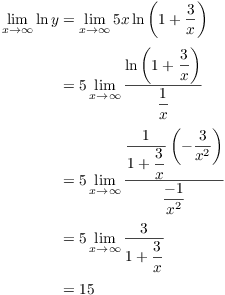L'Hôpital's Rule is a method for computing a limit of the form
![]()
c can be a number, ![]() , or
, or ![]() . The conditions for applying it are:
. The conditions for applying it are:
1. The functions f and g are differentiable in an open interval containing c. (c may also be an endpoint of the open interval, if the limit is one-sided.)
2. g and ![]() are nonzero in the open interval, except possibly at
c.
are nonzero in the open interval, except possibly at
c.
3. ![]() is defined,
or is
is defined,
or is ![]() , or is
, or is ![]() .
.
4. As ![]() ,
,
![]()
If these conditions hold, then
![]()
In other words, f and g may be replaced by their derivatives.
Note that you're not applying the Quotient Rule to ![]() .
.
A proof may be given using some advanced results (e.g. the Extended Mean Value Theorem). I won't give a proof here.
Example. Compute
![]()
Plugging ![]() into
into ![]() gives
gives ![]() , so I can
apply L'Hôpital's Rule:
, so I can
apply L'Hôpital's Rule:
![]()
Example. Compute
![]()
Plugging ![]() into
into ![]() gives
gives ![]() , so I can
apply L'Hôpital's Rule:
, so I can
apply L'Hôpital's Rule:
![]()
Example. Compute
![]()
As ![]() ,
, ![]() , so I can apply L'Hôpital's Rule:
, so I can apply L'Hôpital's Rule:

Example. Compute
![]()
As ![]() ,
, ![]() , so I can't apply L'Hôpital's Rule. In
fact, since the top and bottom are both positive,
, so I can't apply L'Hôpital's Rule. In
fact, since the top and bottom are both positive,
![]()
Example. Compute
![]()
As ![]() ,
, ![]() (which is not 0!). I convert the expression
into a fraction by rationalizing:
(which is not 0!). I convert the expression
into a fraction by rationalizing:
![]()
As ![]() ,
, ![]() , so I could apply L'Hôpital's
Rule. Instead, I'll divide the top and bottom by x:
, so I could apply L'Hôpital's
Rule. Instead, I'll divide the top and bottom by x:

If you apply L'Hôpital's Rule, and the limit you obtain is undefined, you may not conclude that the original limit is undefined.
Example. Compute
![]()
As ![]() ,
, ![]() , so I can apply L'Hôpital's Rule:
, so I can apply L'Hôpital's Rule:

The last limit is undefined, because ![]() has no
limit as
has no
limit as ![]() . This implies that the
. This implies that the ![]() 's in the reasoning above aren't valid. When you do a
L'Hôpital computation, the equalities are actually provisional,
pending the existence of a limit in the chain.
's in the reasoning above aren't valid. When you do a
L'Hôpital computation, the equalities are actually provisional,
pending the existence of a limit in the chain.
In fact, the original limit exists:

You can handle the indeterminate form ![]() by using
algebra to convert the expression to a fraction, and then applying
L'Hôpital's Rule.
by using
algebra to convert the expression to a fraction, and then applying
L'Hôpital's Rule.
Example. Compute
![]()
As ![]() ,
, ![]() . So
. So
![]()
As ![]() ,
, ![]() , so I can apply L'Hôpital's Rule:
, so I can apply L'Hôpital's Rule:

The indeterminate form ![]() can be handled by
taking logs, computing the limit using the techniques above, and
finally exponentiating to undo the log.
can be handled by
taking logs, computing the limit using the techniques above, and
finally exponentiating to undo the log.
Example. Compute
![]()
As ![]() ,
, ![]() .
.
Let ![]() .
Then
.
Then
![]()
So

Therefore,
![]()
Example. Compute
![]()
As ![]() ,
, ![]() .
.
Let ![]() . Then
. Then
![]()
So
![]()
As ![]() ,
, ![]() . So convert the expression to a
fraction:
. So convert the expression to a
fraction:

As ![]() ,
,  , so I can
apply L'Hôpital's Rule:
, so I can
apply L'Hôpital's Rule:

![]()
That is, ![]() . Therefore,
. Therefore,
![]()
Example. Compute ![]() .
.
As ![]() ,
, ![]() . Set
. Set ![]() . Take
logs and simplify:
. Take
logs and simplify:
![]()
Take the limit as ![]() , applying L'Hôpital's rule to
the fraction:
, applying L'Hôpital's rule to
the fraction:

Hence, ![]() .
.![]()
Example. Compute ![]() .
.
This is an indeterminate form ![]() . Combine the fractions over a common denominator:
. Combine the fractions over a common denominator:
![]()
This is an ![]() form, so I can apply L'Hôpital's
Rule:
form, so I can apply L'Hôpital's
Rule:

Copyright 2018 by Bruce Ikenaga